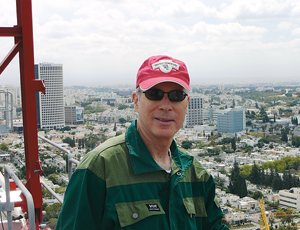Aviad Shapira, civil engineering professor, textbook author and former project engineer for his family’s concrete construction business, is not afraid to climb hundreds of feet up a rickety ladder to get a bird’s-eye view of the world. “I climb tower cranes whenever I get the chance,” he says. “Too many of us researchers are detached from the subject.”

The high-level view has afforded Shapira a unique perspective. The teacher at The Technion-Israel Institute of Tech- nology, Haifa, says many crane accidents can be attributed to what he calls a difference in culture.
If the idea sounds strange, think Old World versus New World: Mobile cranes—crawler and truck-mounted rigs—tend to dominate U.S. sites because of the availability of work space. Tower cranes—handy for hoisting materials in tight, urban areas—are the lifeblood of sites in Europe, Asia and Middle East.
Crane culture shock has come to the U.S., Shapira says. Mobile cranes evolved from the American steam shovel; tower cranes evolved out of European shipyards. Tower cranes restrict operators through electronic aids; mobile cranes leave more freedom to the operator. This list goes on, but each requires its own precautions to ensure workers go home at shift’s end.
These distinctions have gained importance as tower cranes become an efficient tool in the U.S. for all types of projects, with the number of cranes perhaps tripling in the last decade, experts say. This change has set up the domestic industry for trouble. “The way I see it, this rapid culture change is the ground on which the spate of accidents [is based], even if there is no scientific way to prove the cause and effect,” Shapira explains. Last year, two tower-crane accidents in New York City and one in Miami left 11 people dead and sparked a nationwide debate over safety regulations (ENR 8/25 p. 40).
Though he admits tower cranes have gained in number here, one manufacturer is not yet convinced the U.S. is inexperienced. “Every accident is certainly different,” says Glen Tellock, CEO of Manitowoc, Wis.-based crane-maker Manitowoc Co. Inc. “But I don’t think the statistics are really all that different between tower and mobile hydraulics when you look at the root cause.”
Shapira is trying to measure, then prioritize the risks to find out. Two papers published this year in the Journal of Construction Engineering and Management detail a four-year study that concludes most contractors working in a mobile-crane culture are woefully unprepared to deal with tower-crane hazards.
| Site-level safety management | 14.18% |
| operator proficiency | 12.90% |
| Wind | 9.50% |
| Superintendent’s character | 9.16% |
| Maintenance management | 8.88% |
| Company-level safety management | 7.41% |
| Overlapping cranes | 7.02% |
| Operator’s character | 6.27% |
| Signalperson’s experience | 5.98% |
| Blind lifts | 5.63% |
| Type of load | 4.69% |
| Employment source (operator) | 4.52% |
| Length of work shift (operator) | 3.96% |
| SOURCE: JOURNAL OF CONSTRUCTION ENGINEERING AND MANAGEMENT, APRIL 2009, P. 316. | |
The study, funded by a grant from the National Insurance Institute of Israel, is the first to quantify tower-crane risks, Shapira says. Critics argue the study lacks hard, scientific data, but crane safety “is not a hard science like concrete,” remarks Clifford J. Schexnayder, professor emeritus at Arizona State University and co-author with Shapira of the textbook “Construction Planning, Equipment and Methods,” which, like ENR, is published by McGraw-Hill Cos.
As tower cranes gain in number, “the need arises to address safety issues…in a culture that is slowly embracing these machines but has not yet been broadly exposed to such issues, nor has it yet developed methods and tools to deal with them,” says the first paper, published in January. The second paper, published in April, defines the top risks. Human factors, quality of supervision and project conditions make up nearly 91% of the risks. The balance (9.5%) is environmental, mostly wind-related (see table).
The list, supplied by top contractors in Israel—a country that uses about the same number of tower cranes as the U.S. but contains a population the size of Chicago—was whittled down to 13 from a few dozen factors. Shapira has written two more papers, yet to be published, that will allow owners to plug safety factors into a model to create a risk-management plan. “You need to find other metrics to measure, preferably in a quantitative manner, how safe a site is,” he says.


Post a comment to this article
Report Abusive Comment